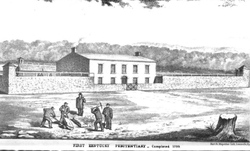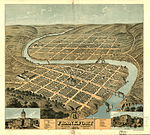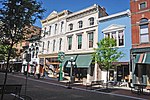Frankfort Cemetery
1844 establishments in KentuckyCemeteries established in the 1840sCemeteries on the National Register of Historic Places in KentuckyNational Register of Historic Places in Frankfort, KentuckyProtected areas of Franklin County, Kentucky ... and 1 more
Rural cemeteries

The Frankfort Cemetery is a historic rural cemetery located on East Main Street in Frankfort, Kentucky. The cemetery is the burial site of Daniel Boone and contains the graves of other famous Americans including seventeen Kentucky governors and a Vice President of the United States.The cemetery is built on a bluff overlooking the Kentucky River with views of the Kentucky State Capitol, the Kentucky Governor's Mansion, downtown Frankfort, south Frankfort, and the Capitol District.
Excerpt from the Wikipedia article Frankfort Cemetery (License: CC BY-SA 3.0, Authors, Images).Frankfort Cemetery
East Main Street, Frankfort
Geographical coordinates (GPS) Address Nearby Places Show on map
Geographical coordinates (GPS)
| Latitude | Longitude |
|---|---|
| N 38.197833333333 ° | E -84.867166666667 ° |
Address
East Main Street 213
40601 Frankfort
Kentucky, United States
Open on Google Maps








